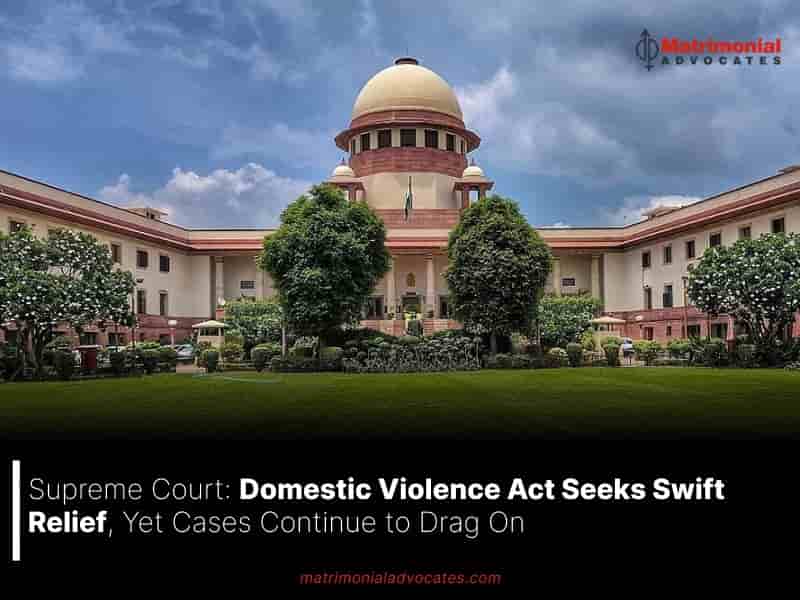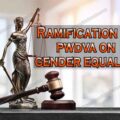
On Monday (November 4), the Supreme Court expressed concerns over the sluggish pace of cases filed under the Protection of Women from Domestic Violence Act, 2005 (PWDVA), highlighting that their progression is akin to that of standard Family Court cases.
The bench, comprising Justices B.V. Nagarathna and Pankaj Mithal, emphasized that while the PWDVA was designed to offer a “quick remedy,” the cases associated with this legislation are being unnecessarily delayed.
The Court was considering a petition submitted by the NGO ‘We The Women of India,’ for which it had previously issued directives to ensure the Act’s effective implementation.
Senior Advocate Shobha Gupta, representing the petitioner, clarified that the PWDVA features an “assistance network” comprising Protection Officers, Service Providers, Shelter Homes, and medical facilities to aid women in need. However, data gathered by the network shows that in several states, Protection Officers are assigned extra responsibilities.
The law requires at least one Protection Officer to be appointed per district.
She said: “The reply to this writ petition shows that not in all States they have one Protection Officer in each district that too on regular basis. The reply shows in many of the States they have persons with additional charge. So, Child Development Protection Officer will also be given an additional charge…Same goes with Service Providers. Shelter Homes to be available as per Section 6 in near vicinity needed to be one than one. We don’t have good shelter homes.”
In reference to the Union’s affidavit, Gupta pointed out that it acknowledges that many Protection Officers are given additional responsibilities. She also referenced the Union Government’s mention of Mission Shakti and One Stop Centres, noting that responses to some calls made to these centers were “less than satisfactory.”
According to the April affidavit, Gupta emphasized that out of 3,637 Protection Officers, only 710 hold permanent positions, while the rest are managing additional duties.
Additional Solicitor General Aishwarya Bhati interjected, indicating that an updated status report would be provided for the petitioner’s review.
To this, Justice Nagarathna remarked: “We find Domestic Violence Act is proceeding as if its a maintenance case or any other case before the Family Court. These cases are going on like this only. So, the various reliefs due to the aggrieved party as per Section 17 onwards, how quickly those reliefs could be granted is the question. They are going as if they are family court matters..This is for a quick remedy. It’s not a Family Court matter to be dragged on. Even there, it’s not supposed to be dragged on. Implementation of the Act must be seen. Why is there delay?”
Justice Nagarathna proposed that the states be included as parties in the case, given their responsibility for appointing Protection Officers.
The Court scheduled the next hearing for December 2, acknowledging that the petition’s requests were extensive. It instructed the petitioner to file a consolidated application that incorporates specific recommendations from the Union of India regarding the requested directions. Copies of the writ petition and key Court orders will be sent via email to the Standing Counsel for each state and union territory.
Background
On February 25, 2022, the Court recognized the petition and requested state-specific data regarding litigation under the PWDVA. It also asked for details about central programs or initiatives that offer assistance under the Act, as well as general guidelines for establishing a permanent cadre of Protection Officers, including their career progression and cadre structure.
After additional orders were issued, the National Legal Services Authority (NALSA) carried out a study, which found that as of July 1, 2022, there were 471,684 pending cases under the PWDVA, along with around 21,008 pending appeals and revision petitions. Information regarding the appointment of Protection Officers in various states was also collected and presented to the Court.
A bench consisting of Justices S. Ravindra Bhat and Dipankar Datta assessed the information and characterized the overall situation as “dismal.” They observed that many states had appointed only a small number of Protection Officers, with some assigning extra duties to these officers and others appointing just a single Protection Officer per district.
The Court also cited an affidavit from the Union Government indicating that “Mission Shakti,” an initiative from the Ministry of Women and Child Development (MWCD), has been established as an overarching scheme to enhance women’s safety, security, and empowerment. As part of this initiative, 801 “One Stop Centres” have been launched.
The Union informed the Court that all centers are functioning. However, the Court remarked that it has not received adequate information regarding the specific responsibilities of Protection Officers or an explanation for the 441,000 pending cases across 801 districts.
The Court observed that appointing just one Protection Officer in certain districts is grossly insufficient, as this would mean each officer would need to manage an average of at least 500 cases.
The Court stated, “The responsibilities given to each Protection Officer are demanding and considerably different from those of judicial officers. By law, Protection Officers are required to perform on-the-spot surveys, conduct inspections, and facilitate communication between victims, the police, and the judicial system. Their reports, especially for emergency orders, are critical. Therefore, it is essential for the Union of India to carefully evaluate these factors.”
Subsequently, on February 24, 2023, the Court provided the following directives:
- The Secretary of the Union Ministry of Women and Child Development (MWCD) is instructed to convene a meeting with the Principal Secretaries of all States and Union Territories to discuss the shortage of Protection Officers under the PWDVA. This meeting should also include the Union Finance Secretary, the Secretary of the National Commission for Women, a representative of the Chairperson of the National Human Rights Commission, the Secretary of the Union Ministry of Home Affairs, the Secretary of Social Justice and Empowerment, and a representative from the Chairperson of NALSA.
- The meeting will concentrate on establishing the number of cases assigned to each Protection Officer, the number of courts each officer oversees, the current number of Protection Officers in each district, and whether this staffing level adequately addresses local requirements. The Court requested recommendations for guidelines to determine the appropriate number of Protection Officers and instructed that an empirical study be carried out to gather information from states regarding their experiences with implementing the PWDVA.
- The MWCD is required to submit an updated report on the implementation status of Mission Shakti. This report should include information on the number of One-Stop Centres proposed for each district, the number currently operational, their locations, staffing structures, required personnel, and types of workloads. Additionally, it should specify whether hospitals, police stations, and local bodies are expected to display contact information for the One-Stop Centres.
- The Union is tasked with detailing the provisions of the PWDVA in relation to Mission Shakti and explaining how it will function as an overarching scheme for implementing the PWDVA. Authorities were directed to submit an action taken report within six months.





